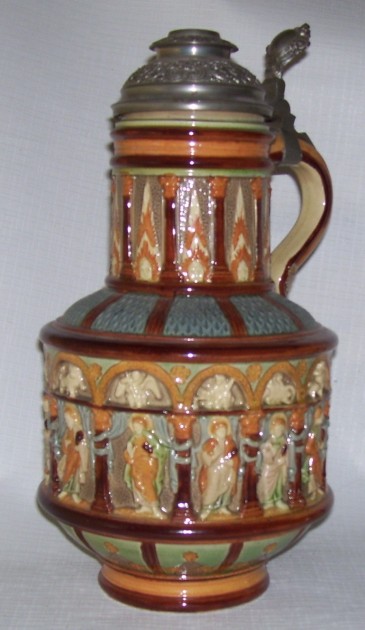
The Apostles (who are all saints) in relief around the body of this circa 1890’s majolica serving pitcher. The small relief figures in white above the saints are the Zodiac signs, and the flaming heads are angels I believe, whether “Thrones” or “Seraphims” remains to be determined.
Christian angelic hierarchy:
Apostle Steins (Individual Saint steins are found below.)
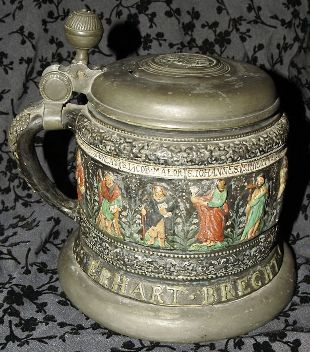
.
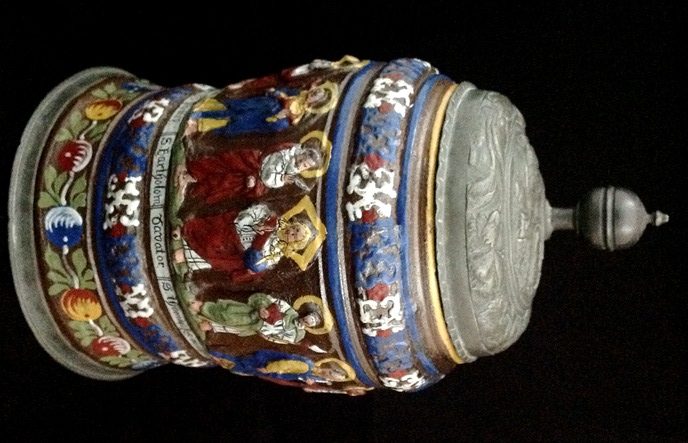
JM. DH]
Apostle steins (Apostelkrug) – Early pottery steins made in and around Kreussen (also Cruessen), Germany, in the mid to late 1600’s. The relief and enameled figures celebrated the 12 Apostles and Jesus. Highly collectable and very, very reproduced over these many years. Shown far above: A 6 inch, to the top of the lid; an authentic one; most are larger. Dated 1666. Just above : A much nicer example, Circa 1660.
.
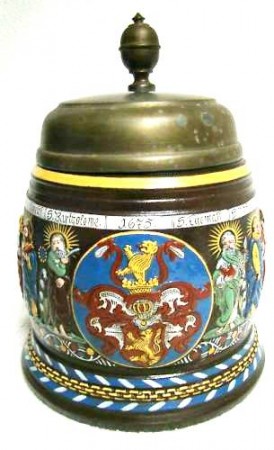
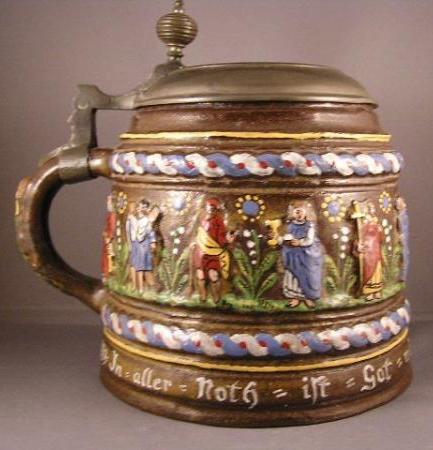
Above: Two late 1800’s reproduction Apostle steins. [both FWTD]
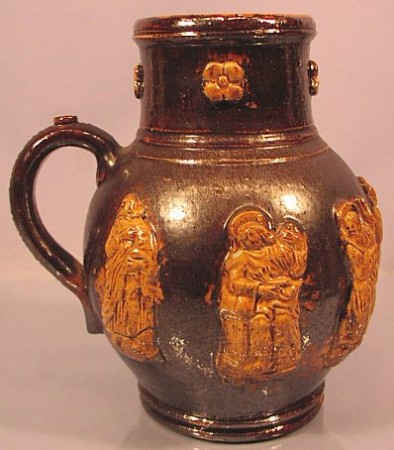
Apostelkrug made by P. Spielbühler of Thurnau, Bavaria, 4.5-inch. Very modern, but I think nice looking.
.
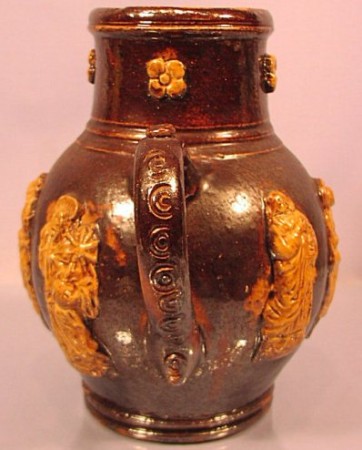
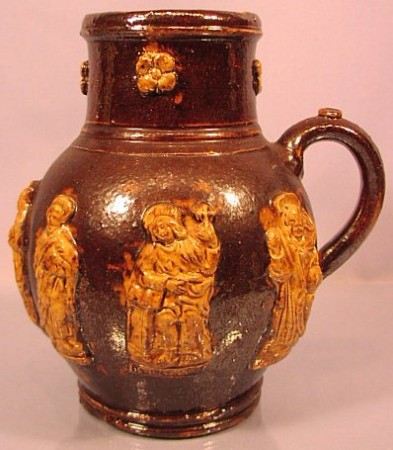
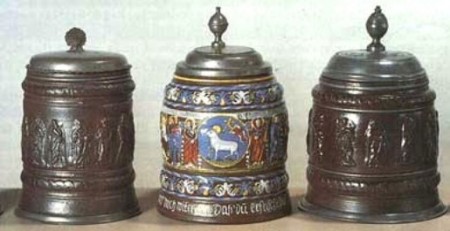
All three shown above are from Creussen in the late 1600’s. These are also called Apostle steins as those are the Saints that are featured. Of course the colored version now sells for lots more than the plain brown relief.
.
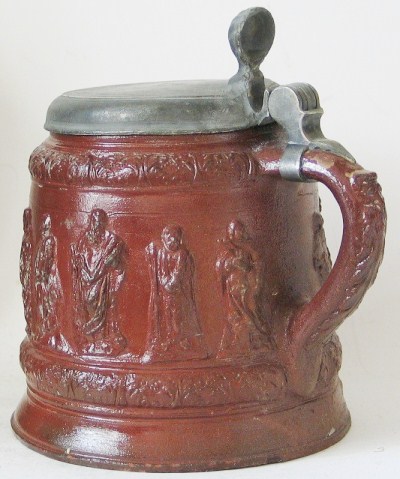
An unpainted one liter example of an Apostle’s stein, now in the FWTD collection. The reddish-brown c0lor threw a lot of collectors “off” of this one, which was fine with me!
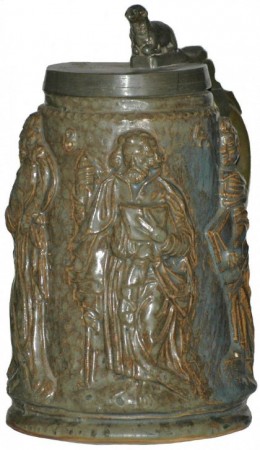
Hafnerware, one liter Four Saints = Matthew, Mark, Luke and John. Ca. 1840 [RFA ]
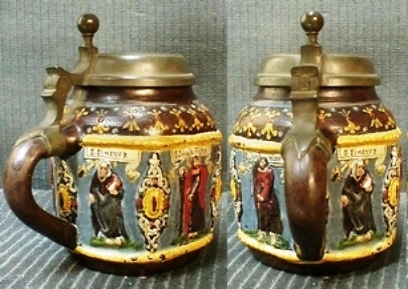
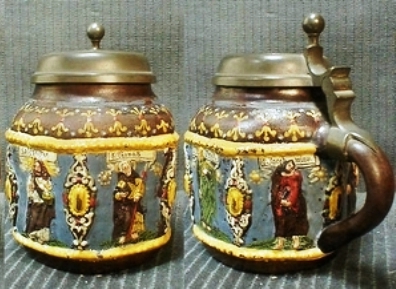
.5 liter Apostle’s stein. Newer version, Unknown maker. Circa 1890.
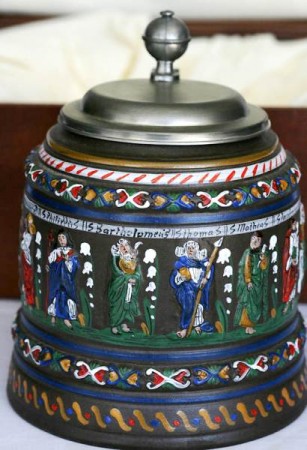
A new “limited edition” of an Apostle’s stein. Made by Gerz.
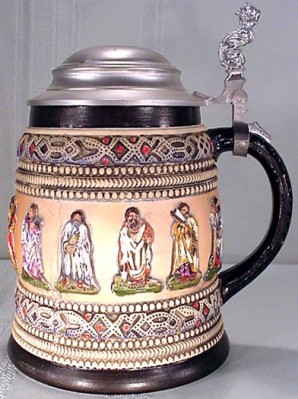
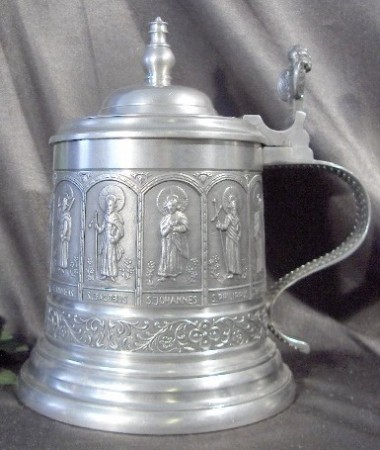
[L] A recent ceramic version. Some of the so called “Antiques of the future?” [R] ” Brand new” pewter.
Saint’s steins:
Steins devoted to one’s favorite or named sake Saint have been around for hundreds of year and as one will see they are made in just about every material one can imagine, except perhaps serpentine / marble. The ones I prefer to collect are the old glass steins with engraved images, and many of those are posted here on this page. These were made originally for a person’s favorite saint, birthday of a saint, or “middle named as a Saint, especially for “Conformation” (a ceremony of coming of age to” believe” for one’s self) when a child take the name of a favorite Saint and adds it to their own.
There were also many done in fayence and a few in old pottery. All types of these were very popular in the mid to late 1700’s, and just into the early 1800’s. Then for some reason devotion to the Saints on beer steins stopped so by the late 1800’s one doesn’t find them hardly at all (V & B being the exception.)
Done by a few special artists, these steins of mine are now hard to find and expensive on both sides of “The Pond.” I have seen (only) one Saint’s stein engraved on cobalt blue glass; very interesting and pretty! [And the “lady” wouldn’t sell him to me!]
I know that no one except Catholics and other Orthodox religions (and people brought up under those religions by their parents) know virtually nothing about” Saints.” So I will on these pages try to endeavor to alleviate that problem by showing representative samples for all the “major old Europe saints” that might be depicted on beer steins. Hopefully this file will be used by some of the USA stein auctioneers who constantly do not know (or probably care) what they are looking at when they are describing a stein for sale.
This lack of knowledge recently permitted one auctioneer to list the glass stein shown below as “Christ with his cross”, when in fact it was St. Anthony and his cross = the “X” cross, as Anthony asked not to be crucified exactly as Jesus was as he didn’t think he was worthy of that honor. Another example of the lack of knowledge in this subject area was shown towards St.Martin (below) when he was called “a knight on a horse!”
INDIVIDUAL SAINTS:
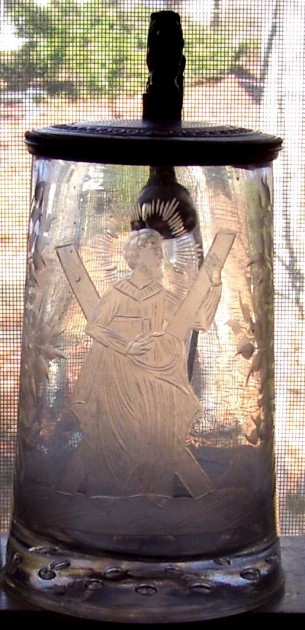
“St. Andrew” [1] – Shown: 1/2 liter blown glass with air bubbles in the base, rough pontil mark, and a small lion thumblift. Ca. 1830 -40. St. Andrew’s attribute is of course the “X” cross.
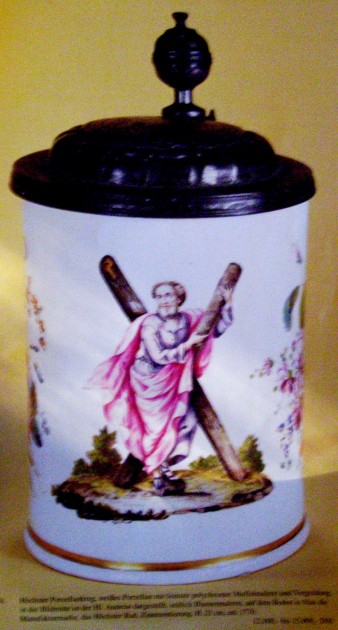
St. Andrew [2]- The almost identical scene of St. Andrew on a fayence stein shown in a J.Vogt (Munich) catalog.
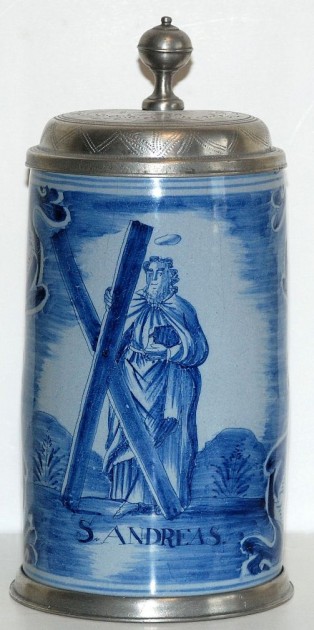
St. Andrew [2] – ( Photo compliments of William Hamer)
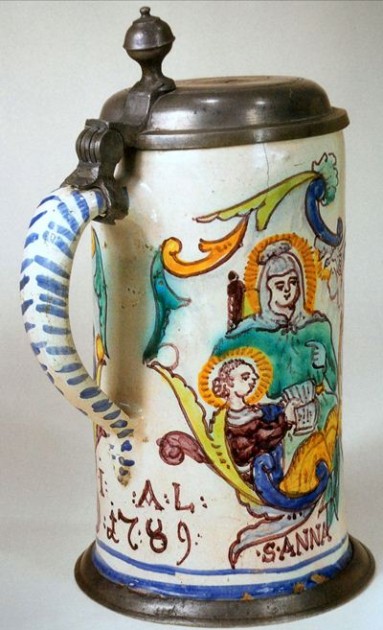
St. Ann (Anna) [1] – The mother of The Virgin Mary, or of course, Jesus’ grandmother. ( Photo compliments of William Hamer)
. .
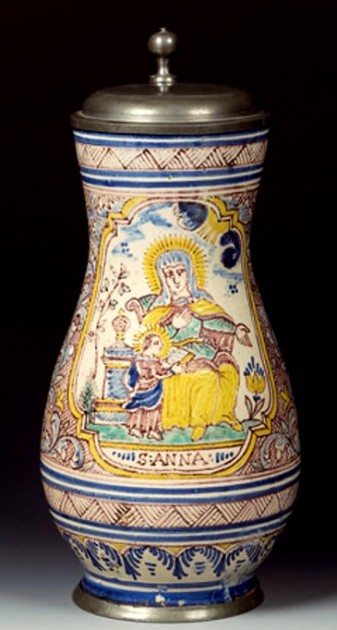
St. Ann (Anna) [2] – The mother of The Virgin Mary. Austrian Ca, 1820. ( Photo compliments of William Hamer.)
.
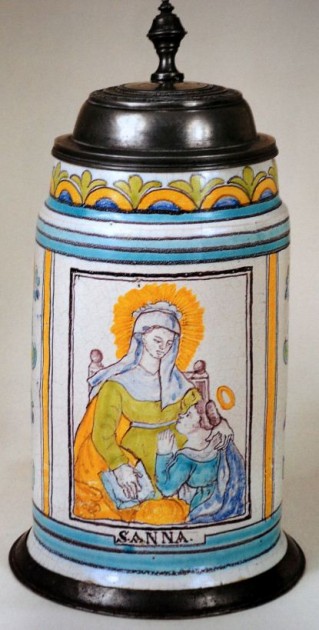
St. Ann (Anna) [3] – The mother of The Virgin Mary. Austrian (Gmunden?) Ca, 1820, ( Photo compliments of William Hamer.)
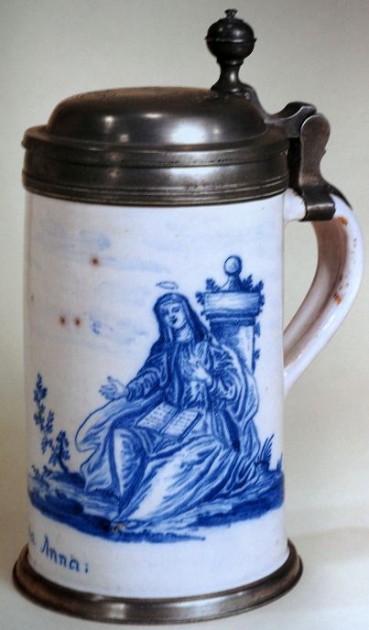
St. Ann (Anna) [3] – The mother of The Virgin Mary. Ca, 1820. The left panel shows Mary [M/O/G]. ( Photo compliments of William Hamer.)
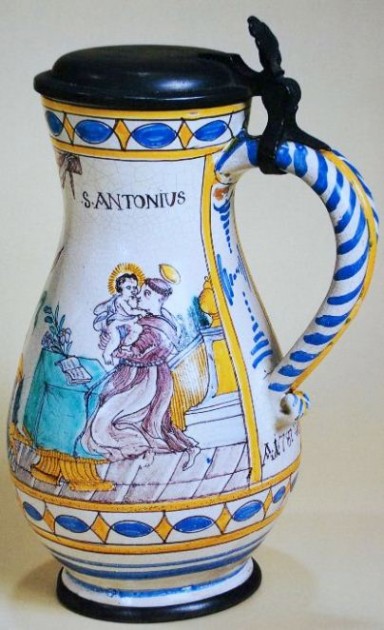
St Anthony – [1] Austrian fayence. . 5 liter, Ca 1820. ( Photo compliments of William Hamer.)
“St. Barbara” [1] – St. Barbara was a (Legendary) virgin and martyr, first mentioned in the early seventh century. Alleged to have died in the third or fourth century, but date is uncertain and place of martyrdom varies. Shown: .5 liter blown clear glass, air holes in the bottom. Circa 1830. The remaining gold leaf make it difficult to photograph. Almost all these type steins had gold leaf applied when new.
St. Barbara is also the Patron Saint of Artillery and can be found in small relief thumblift on some Reservist steins.
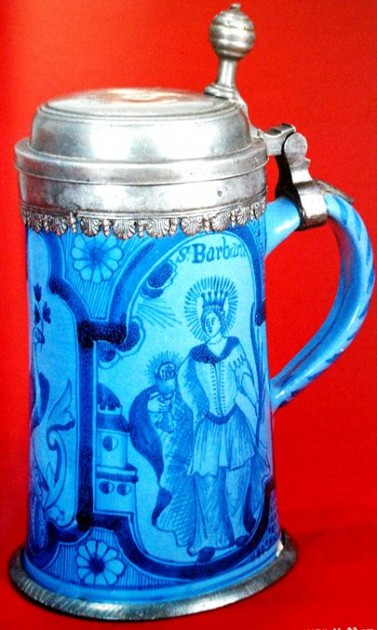
St. Barbara [2] – ( Photo compliments of William Hamer)
.
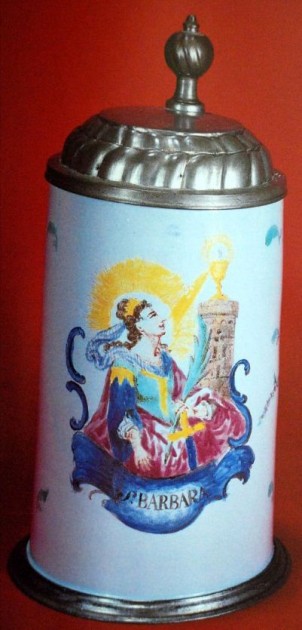
St. Barbara [3] – ( Photo compliments of William Hamer.)
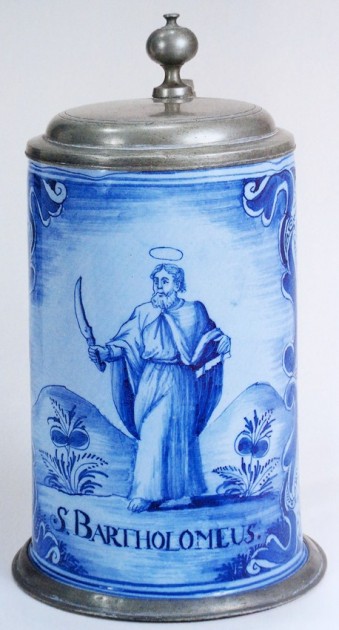
St. Bartholomeus (St. Batholomew) [1] – Bartholomew, Saint – Mentioned in the lists of apostles in the Synoptic Gospels and in Acts, thought to be identical with Nathaniel (mentioned only in the Gospel of John.) Shown above: One liter fayence from TBD.
(Saint Bartholomew’s Day Massacre = This massacre of which Protestants were the victims occurred in Paris on 24 August, 1572 (the feast of St. Bartholomew), and in the provinces of France during the ensuing weeks, and it has been the subject of knotty historical dispute.)
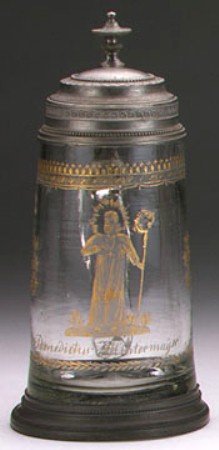
“St. Bernard [?]” [1] – Bernard was Archbishop of Vienna, France. Born in 778; died at Vienne, 23 January, 842. His parents, who lived near Lyons and had large possessions, gave him an excellent education, and Bernard in obedience to the paternal wish, married and became a military officer under Charlemagne.
In 810 he was chosen Archbishop of Vienna to succeed Volfère, but it was only upon the command of Pope Leo III and of Charlemagne that he accepted the honor. He was consecrated by Leidtrade, Archbishop of Lyons, and distinguished himself by his piety and learning. He took part in drawing up the Capitularies of Charlemagne and aided Agobard in a work upon Jewish superstitions. Shown: Engraved glass showing the Saint holding his Crosier (The Pastoral Staff is an ecclesiastical ornament which is conferred on bishops at their consecration.)
Shown above: CA. 1830. Some gilt remaining on the stein. It is unusual for this type to have a pewter base
.
11-9-2012 = photo missing – some how “Word Press” did it again!
St Bernard [2] – ( Photo compliments of William Hamer.)
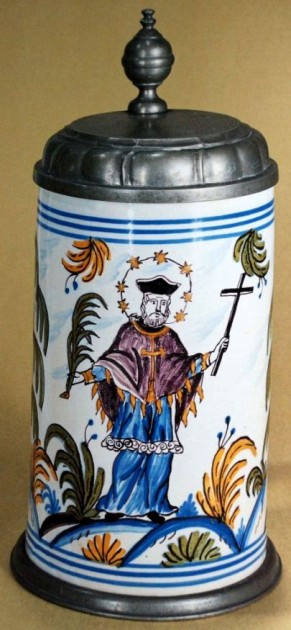 (Photo compliments of William Hamer.)
(Photo compliments of William Hamer.)
I believe this one and the one just below could be St Bernard also
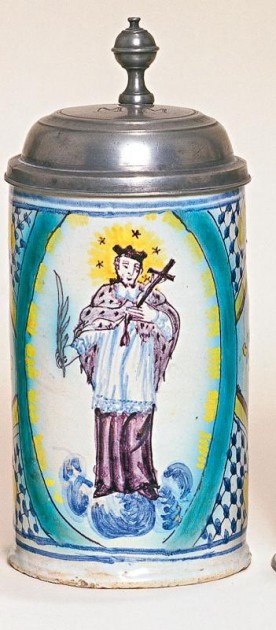
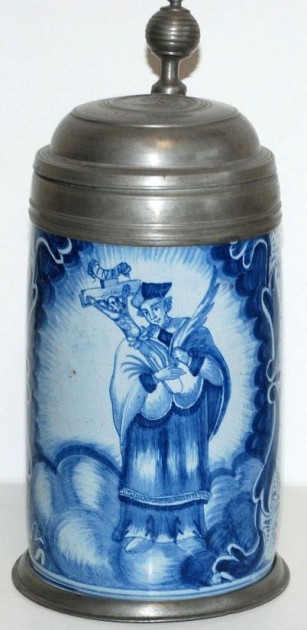
St. Nepomuck- [Palm in Christian Symbolism – A Christian symbol of victory.] (Photo compliments of William Hamer.)
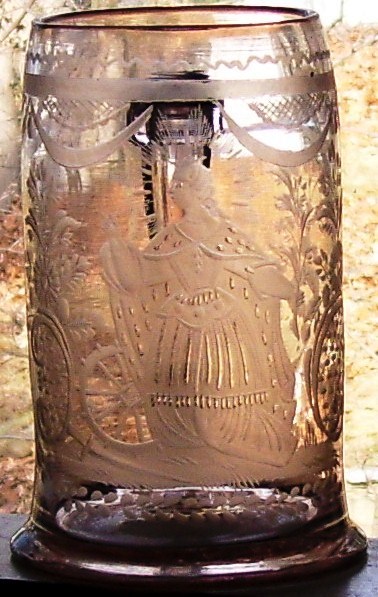
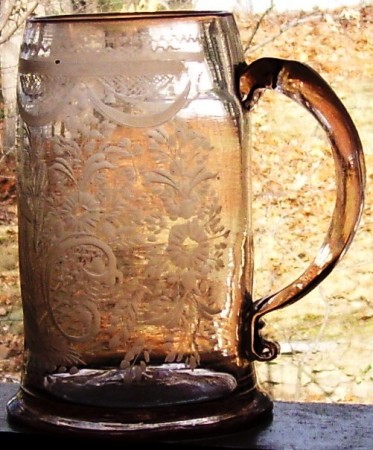
St. Catherine [1] –She wasone of the most popular female saints! Shown: A one liter cut blown clear glass with scene of St. Catherine and her wheel. Engraving by “The Master of the Engraved Saint Steins. Circa 1785. [FWTD]
St. Catherine was a virgin and martyr whose feast is celebrated in the Latin Church and in the various Oriental churches on 25 November, and who for almost six centuries was the object of a very popular devotion.
Of noble birth and learned in the sciences, when only eighteen years old, Catherine presented herself to the Emperor Maximinus who was violently persecuting the Christians, upbraided him for his cruelty and endeavored to prove how iniquitous was the worship of false gods.
Maximinus had Catherine scourged and then imprisoned.Meanwhile the empress, eager to see so extraordinary a young woman, went with Porphyry, the head of the troops, to visit her in her dungeon, when they in turn yielded to Catherine’s exhortations, believed, were baptized, and immediately won the martyr’s crown. Soon afterwards the saint, effected so many conversions, was condemned to die on the wheel, but, at her touch, this instrument of torture was miraculously destroyed. The emperor, enraged beyond control, then had her beheaded and angels carried her body to Mount Sinai where later a church and monastery were built in her honor.
Shown above: Two one liter engraved lidless steins. Her torture wheel is obvious. Circa 1810 – 30
.
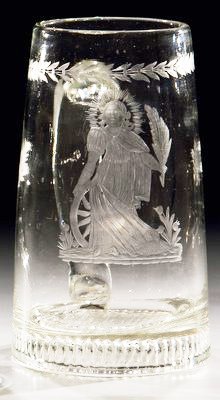
St. Catherine = [2] Above another engraved version of “St. Catherine of Alexandria.”
![1 - ST.CATHERINE) [fwtd]](http://www.steveonsteins.com/wp-content/uploads/2011/12/1-ST.CATHERINE-TO-CROP-OUT-LAMB-279x630.jpg)
St. Catherine [3] – A .5 liter, engraved clear glass stein. Circa 1830-50. Lots of nice workmanship on this one. Besides the spiked wheel which is her attribute, she holds a martyr’s palm in one of her hands on both these steins. [FWTD]
.
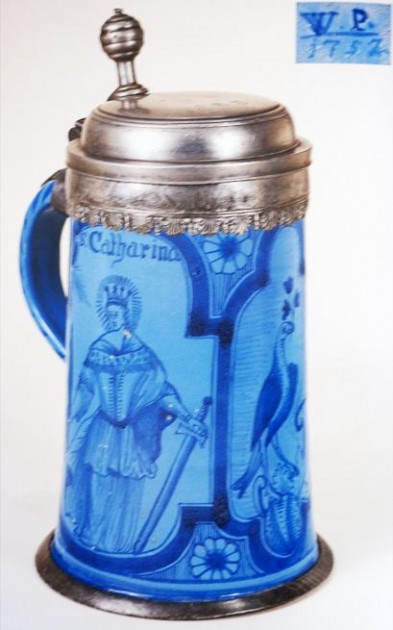
St. Catherine [4] – .5 liter fayence. ( Photo compliments of William Hamer.)
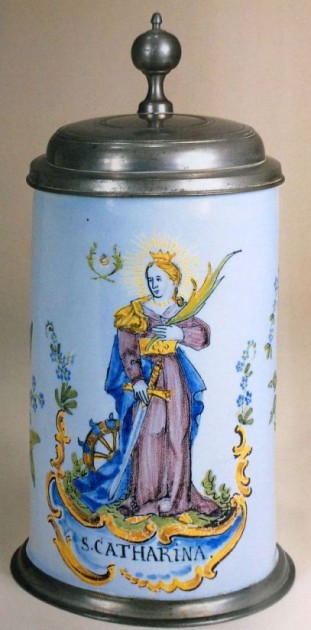
St. Catherine [5] – A one liter fayence. ( Photo compliments of William Hamer.)
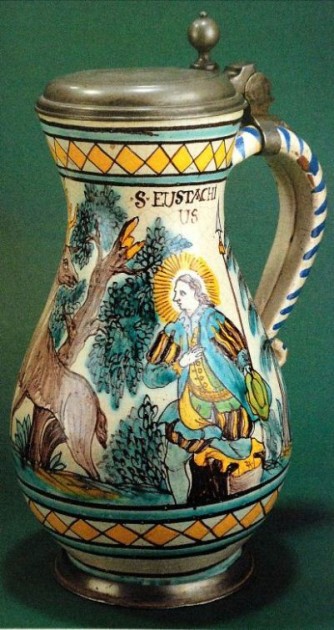
St. Eustice – [1]- (Photo compliments of William Hamer.) It is interesting to note that the legends are almost identical, but St. Eustice’s predates St. Hubertus’ by a couple hundred years. (Photo compliments of William Hamer.)
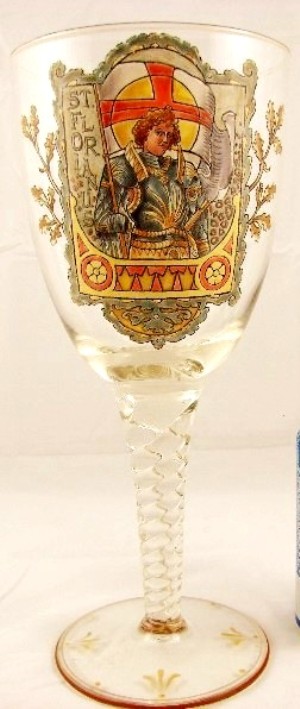
“Saint Florian” [1] – He is the patron Saint of Firefighters, amongst other occupations. Shown: A large clear glass blown wine glass made by Josephinenhütte and most likely decorated by van Hauten, although not signed. [FWTD]
See tab this web site = http://www.steveonsteins.com/van-hautens-enameled-big-question-drinking-wares-draft-2-3-2011
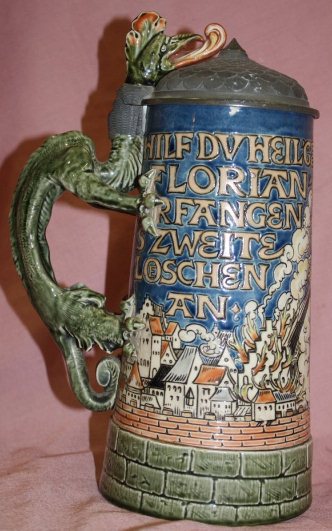
St. Florian [2] -The one liter V & B Mettlach, No. 1786, celebrating St.Florian putting out a burning town (“thirst” in the phrase on the body) with a keg of beer. One of the most popular steins made at V &B, Mettlach. It was made in a .5 liter and a one liter size.
.
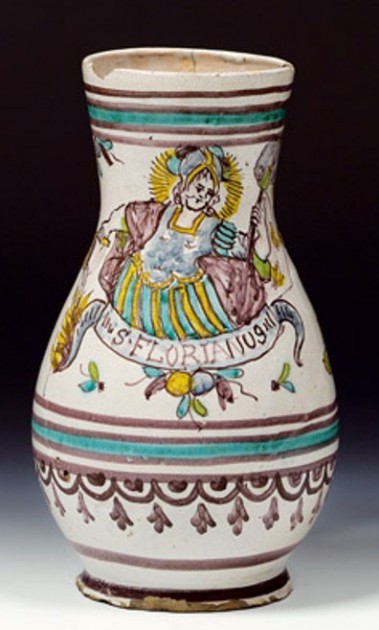
St. Florian [3] – Austrian Fayence beer jug . (Photo compliments of William Hamer.)
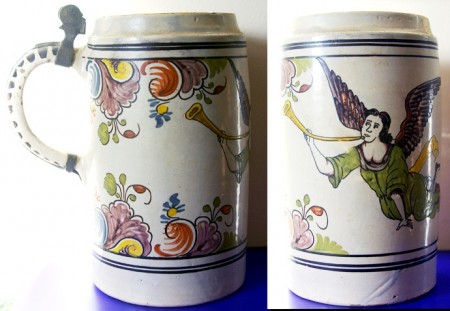
St, Gabriel – The Angel Gabriel – Fayence, 1 liter. Erfurt. Circa 1800.
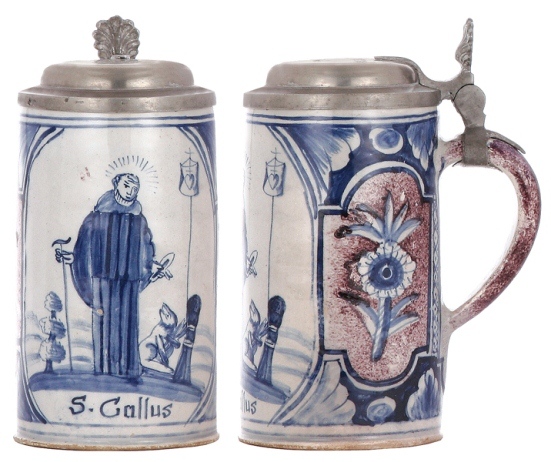
St. Galius, Faience stein, 7.5ht., (possibly) Nürnberger Walzenkrug, c.1800, ,pewter lid dated 1801. [TSACO]
“Saint George” [1] – Saint George was a Roman soldier and priest in the Guard of Diocletian, and who is venerated as a Christian martyr. In hagiography Saint George is one of the most pictured saints in the Catholic, Anglican, Orthodox churches. He is immortalized in the tale of Saint George and the Dragon. The episode of St. George and the Dragon was a legend brought back with the Crusaders and retold with the courtly appurtenances belonging to the genre of Romance. By far the most revered Saint in the Christian world. He is the patron Saint of both England and Russia. Almost every stein maker made at least one stein to honor him (and to sell) including V & B Mettlach. Shown above : A 2 liter saltglazed serving stein by Reinhold Hanke. [FWTD]
THERE ARE A MULTITUDE OF BEER STEINS DEVOTED TO ST. GEORGE, TO SEE MORE GO TO THE END OF THIS PAGE AND I WILL HAVE THEM DISPLAYED THERE.
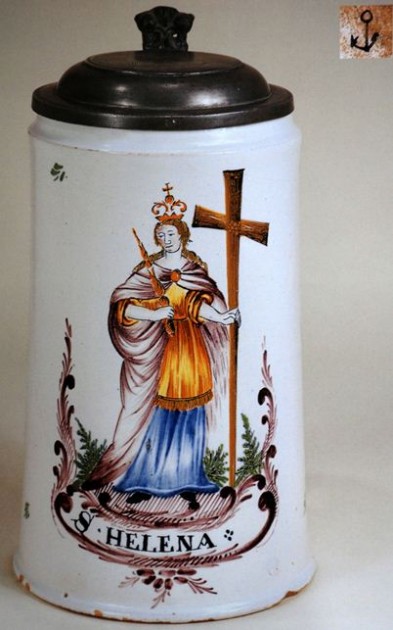
St Helen [1] – (Photo compliments of William Hamer.)
.
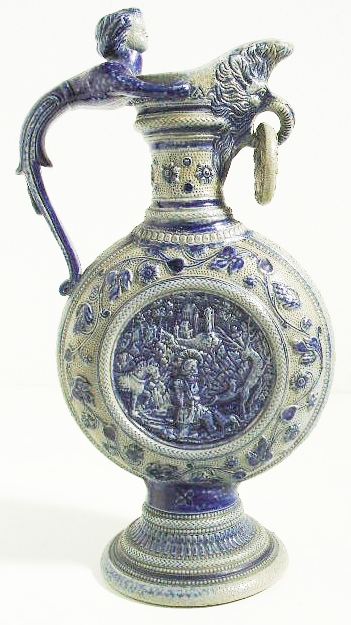
“Saint Hubertus” [1a] – Legend has it Hubertus, born in the seventh century, seeks comfort and distraction on lonely hunts after the death of his beloved wife Princess Floribana in childbirth. One Christmas Eve, he encounters on one of these hunts, the wondrous image of a splendid red albino stag carrying a shining cross between its antlers. Through this vision, Hubert is moved to transform his life. He lays down his high ranks of office and distributes his wealth among the poor and the church.
Shown: A Westerwald saltglazed stoneware relief “wine/ beer jug. About a 3 liter I think. Circa 1885.
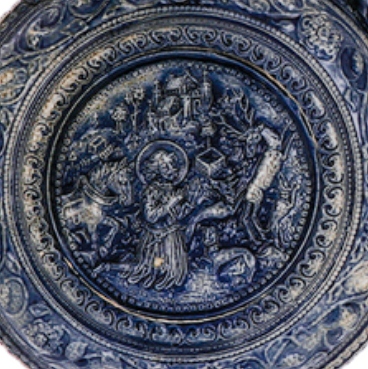
St. Hubertus [1b]- Detail of center scene. Shows the cross between the antlers.
St. Hubertus has been the patron saint of hunters and animal protectionists (Tierschutzverein) in northern Europe who attempt to honor him by sharing their feasts with townspeople, holding charity fundraising festivals and being responsible for the care of animals on their lands, both domestic and wild.

St. Eustice – [1]- (Photo compliments of William Hamer.) It is interesting to note that the legends are almost identical, but St. Eustice’s predates Hubertus’ by a couple hundred years. (Photo compliments of William Hamer.)
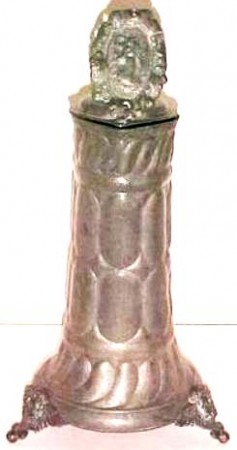
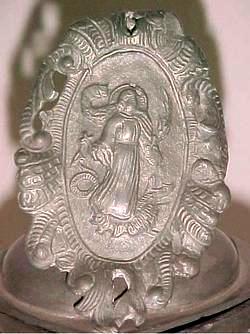
St. Isadore [1] – He was accused by his overseer of taking off time from farming to go to church St. Theodor denied it. The oversee then went to the far fields only to see an angle working the plow for the saint. Shown : 1.5 liter pewter server by Weygang with the Angel(unknown which one) shown in relief on the lid’s shield and St. Theo as a small person in the background. Circa 1890.
.
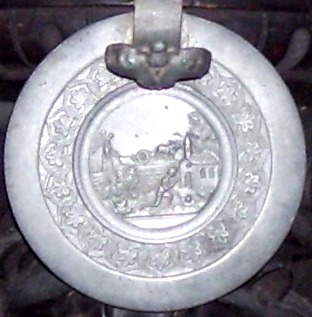
St. Isadore [2] – A relief pewter lid on a blown glass stein. Lid is circa 1840- 1850. Shows: St. Isadore praying at his church, while the angel does his work in his master’s field. He is now the German Patron Saint for Farmers. [FWTD]
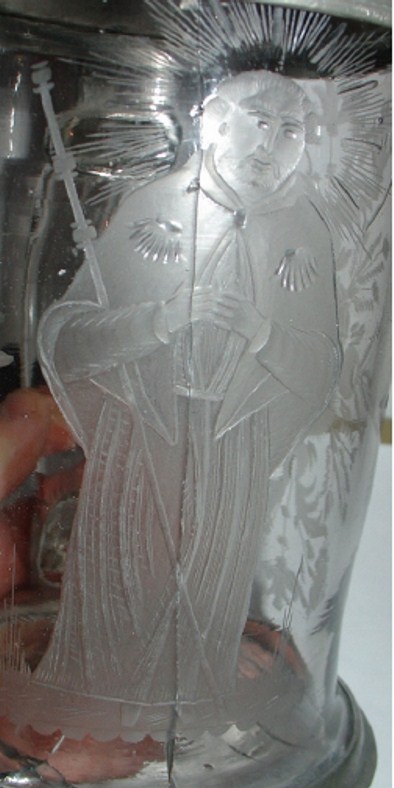
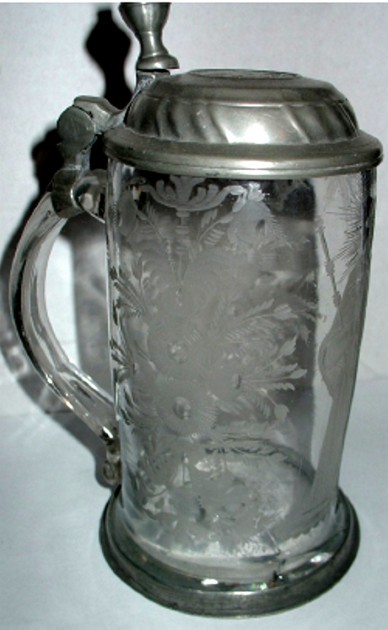
“St. James” [1] – I am almost certain this engraved glass stein was done by the artist I call “The Master of the Engraved Saint Steins, (TMOTESS)”
[ L] Detail – Used in SCI’S magazine PROSIT, Spring 2009, I emailed at least twice and asked for some detailed photos of this stein from the “well know author” of the article. I might of well have asked one of the squirrels outside on my lawn! Thanks a bunch, Steve NOT!
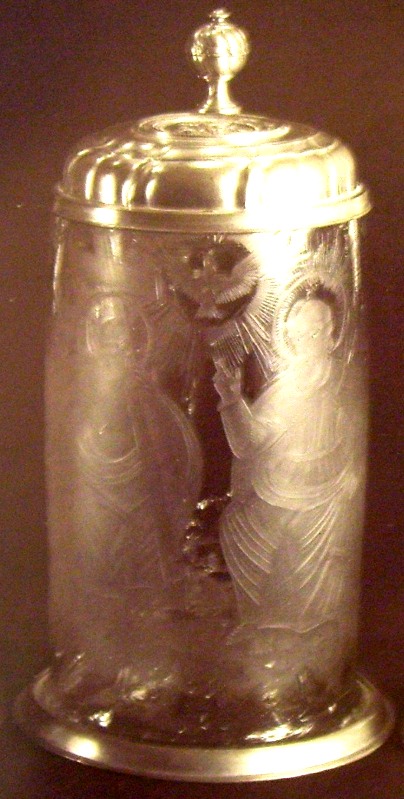
“St. John the Baptist)” [1]
For a very complete history of this John, please see: http://www.newadvent.org/cathen/08486b.htm Shown: A one liter blown and engraved clear glass. Ca. 1780. St John and Jesus and the Holy Spirit (in the form of a dove.) [Old catalog photo]
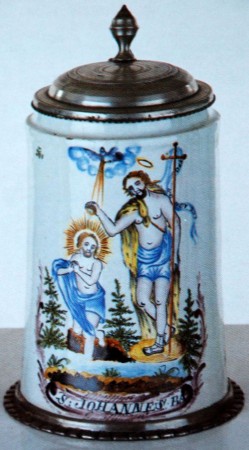
St. John the Baptist [2] – (Photo compliments of William Hamer.)
.
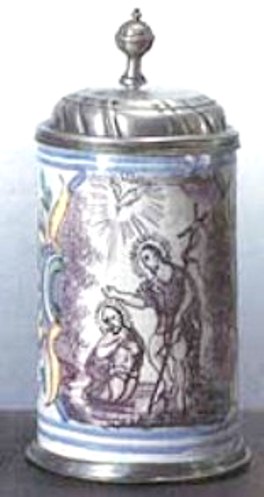
St. John the Baptist [3] – [Photo JV]
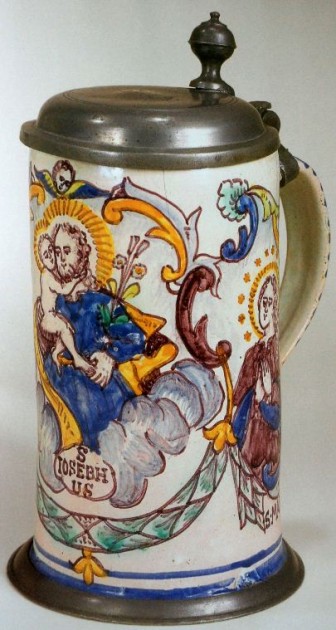
St. Joseph – The ” foster father” of Jesus – as “God ” was supposed to be Jesus’ father. Most always seen with the baby Jesus in his arms, and if not named as above, then confused easily with St. Christopher, who always carries the baby on his shoulder. (Photo compliments of William Hamer.)
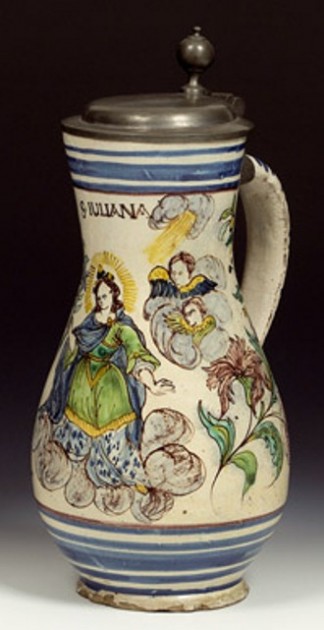
St. Julianna – (Photo compliments of William Hamer.)
![1 - SAINT MARGARITE [SP] STANDING ON DRAGON . DEVIL BY 'TMOTES '](http://www.steveonsteins.com/wp-content/uploads/2011/12/1-SAINT-MARGARITE-SP-STANDING-ON-DRAGON- .-DEVIL-BY-TMOTES--307x630.jpg)
“St. Margaret (Martina)” – St .Margaret on a .5 liter blown and engraved. Circa 1810 . Those are not angel wings as some have been called but part of the gown the women wear that flowed off their shoulder. The scene shows Margaret standing on a serpent, representing the devil. The serpent had swallowed her, but she was so righteous that he had to regurgitate her. [FWTD]
This stein was also done by the artist I call “The Master of the Engraved Saint Steins, (TMOTESS)
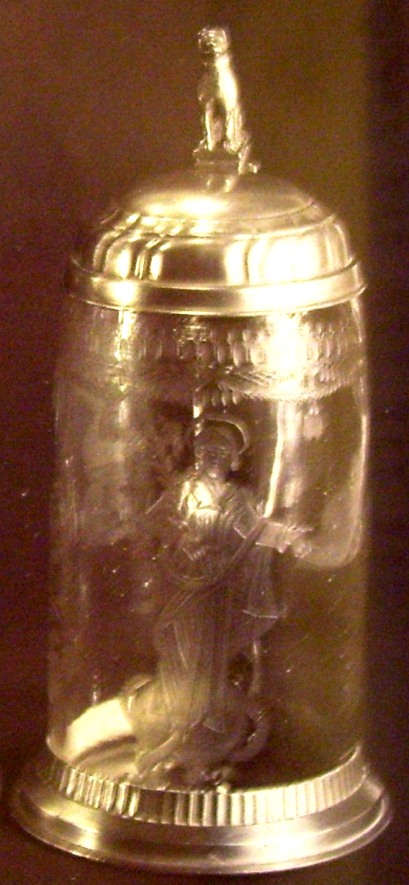
St. Margaret and serpent. Engraved blown glass .5 liter. Circa 1840. I think this one was done by a different artist on a different style stein; fancy pewter base. (Sorry, another bad catalog photo.)
.
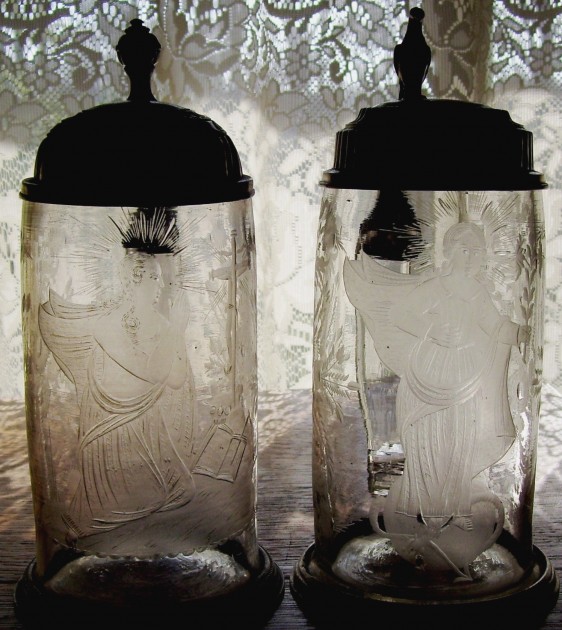
[ R] St. Margaret (the exact stein as shown two above.) [L] St. Mary Magdalene –– see below).
Both were engraved by the artist I call “The Master of the Engraved Saint’s Steins: (TMOTESS)” whose work is in the Bavarian (National) Museum.
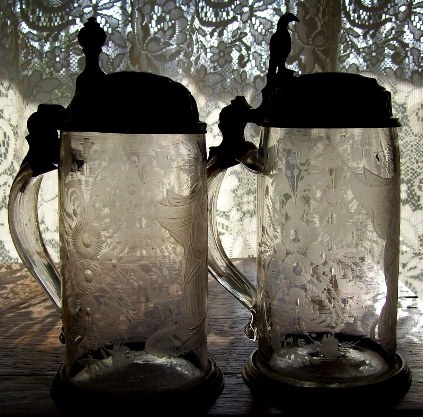
The floral side scenes on two of the saint’s steins engraved by “TMOTESS”
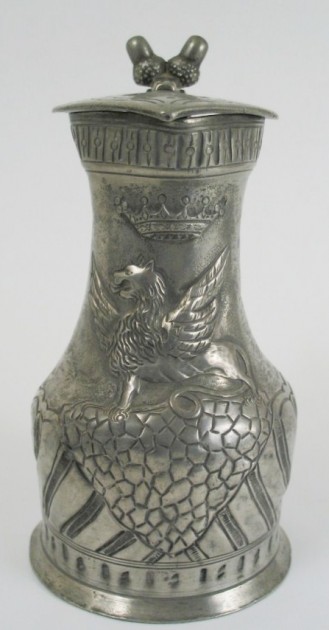
St. Mark – One of the Gospel writers. Graphically depicted as a Lion with wings. Shown: A French wine server Ca. mid to late 1800’s
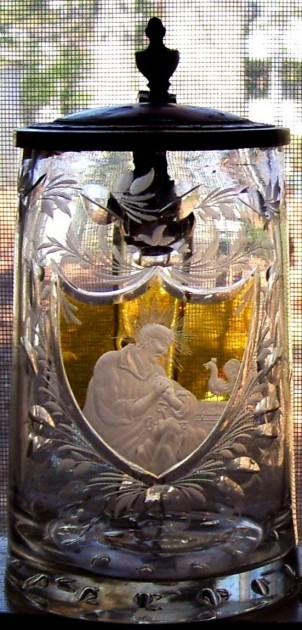
“St. Peter” – Shown: .5 liter, with yellow stain with an engraved scene of St. Peter shown praying for forgiveness with the rooster crowing (three times) in the background. Also made around 1840’s with air bubbles blown into the base. [EX-FWTD]
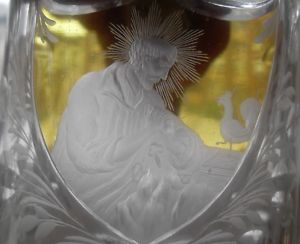
Detail
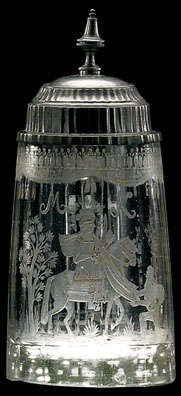
“St. Martin” [1] – St. Martin who is shown here cutting his fine cloak for a beggar. This scene was cataloged as “A knight on his horse” by a us stein auctioneer not too long ago.
“St. Mary Magdalene” [1] – Mary Magdalen was so called either from Magdala near Tiberias, on the west shore of Galilee, or possibly from a Talmudic expression meaning “curling women’s hair,” which the Talmud explains as of an adulteress. In the New Testament she is mentioned among the women who accompanied Christ and ministered to Him (Luke 8:2-3), where it is also said that seven devils had been cast out of her (Mark 16:9). She is next named as standing at the foot of the cross (Mark 15:40; Matthew 27:56; John 19:25; Luke 23:49). She saw Christ laid in the tomb, and she was the first recorded witness of the Resurrection.
Shown: “St. Mary Magdalene,” done by the artist I call “The Master of the Engraved Saint’s Steins, (TMOTESS)”. This stein is in the Bavarian National Museum. Circa 1790. I believe this is a one liter size. While hard to see, her two attributes, an open book (the Bible) and the cross are shown on both.
.
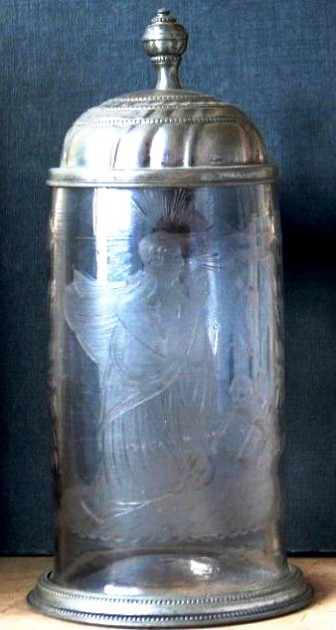
St. Mary Magdalene [2] , .5 liter engraved by (TMOTESS)” – [FWTD]
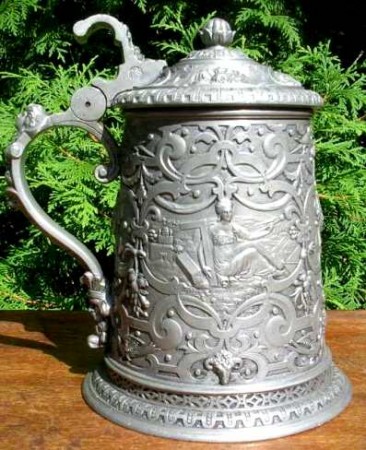
St. Mary Magdalene [3] – Shown: Pewter relief, 1/2 liter (replica of an older 1600’s piece) but this one made in the late 1800’s. She is holding onto the cross with the skull (one of her attributes) by her feet.

St. Mathias – (Photo compliments of William Hamer.)
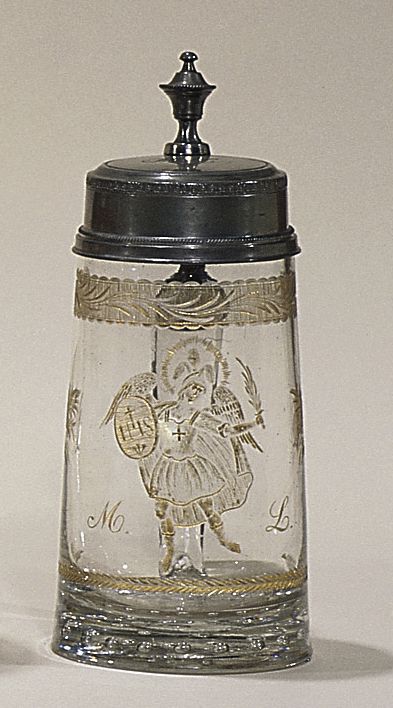
St. Michael, The Archangel – Engraved with applied gold leaf. Bohemian Ca. 1820.
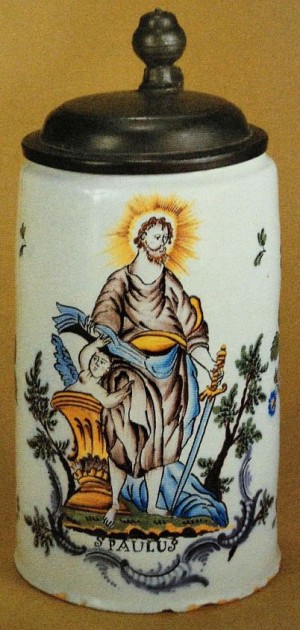
St. Paul – (Photo compliments of William Hamer.)
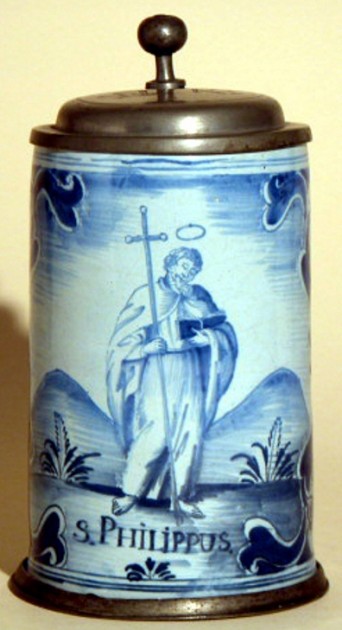
St. Phillip – (Photo compliments of William Hamer.)
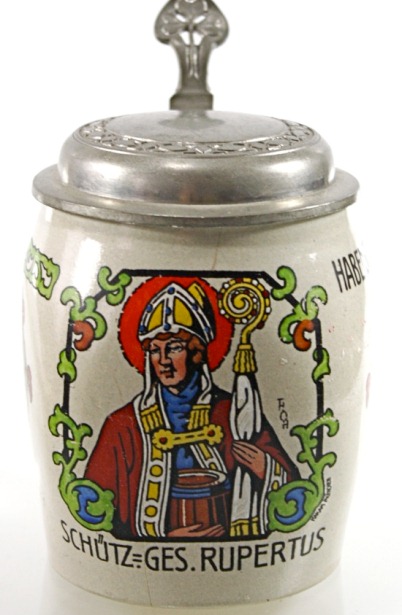
St. Rupert – First Bishop of Saltzberg, coming from the Bishopric of Worms.
For more, see: http://www.newadvent.org/cathen/13229a.htm
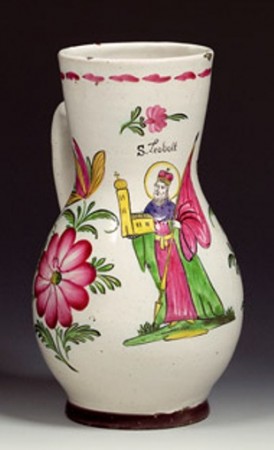
St. Sebaldus [1] – The patron Saint of Nurnburg. Austrian Fayence birnkrug . Ca. 1840. (Photo compliments of William Hamer.)
.
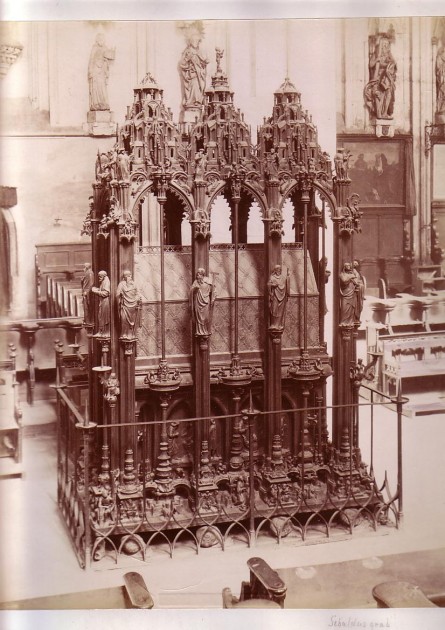
St. Sebaldus’ tomb in Nurnburg.
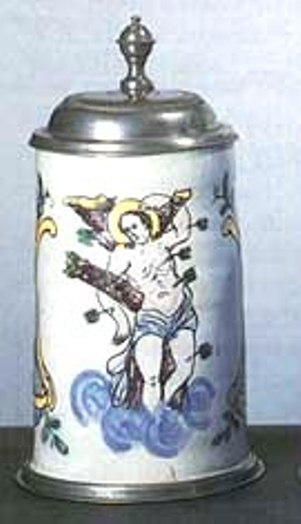
St. Sebastian – [photo: JV] –Roman martyr; little more than the fact of his martyrdom can be proved about St. Sebastian.
The Acts, probably written at the beginning of the fifth century and formerly ascribed erroneously to Ambrose, relate that he was an officer in the imperial bodyguard and had secretly done many acts of love and charity for his brethren in the Faith. When he was finally discovered to be a Christian, in 286, he was handed over to the Mauretanian archers, who pierced him with arrows; he was healed, however, by the widowed St. Irene. He was finally killed by the blows of a club.
These stories are unhistorical and not worthy of belief. The earliest mosaic picture of St. Sebastian, which probably belongs to the year 682, shows a grown, bearded man in court dress but contains no trace of an arrow. It was the art of the Renaissance that first portrayed him as a youth pierced by arrows.
Sebastian is considered a protector against the plague. Celebrated answers to prayer for his protection against the plague are related of Rome in 680, Milan in 1575, and Lisbon in 1599. His feast day is 20 January.
From: http://www.newadvent.org/cathen/13668a.htm
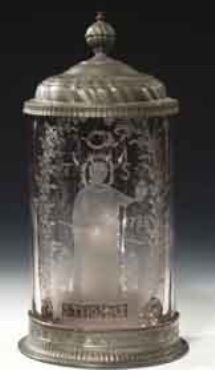
St. Thomas – (called that – Dated 1788. Sold at Fischer’s (Germany auction in 2009. (E catalog photo.)
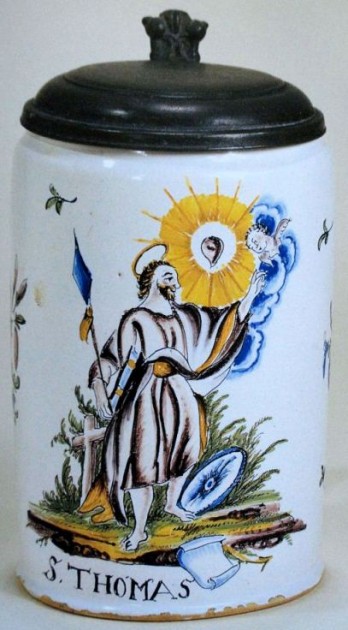
St. Thomas [2] – (Photo compliments of William Hamer.)
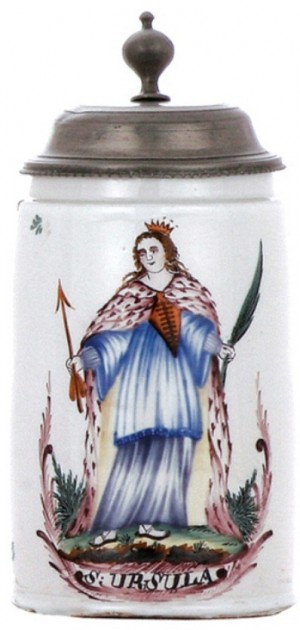
St. Ursula – (Photo compliments of William Hamer.)
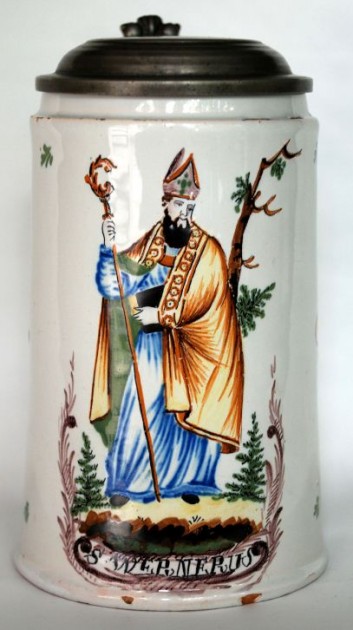
St. Werner – (Photo compliments of William Hamer.)
UNDETERMINED SAINTS – CAN ANY OF YOU READERS HELP ME OUT?
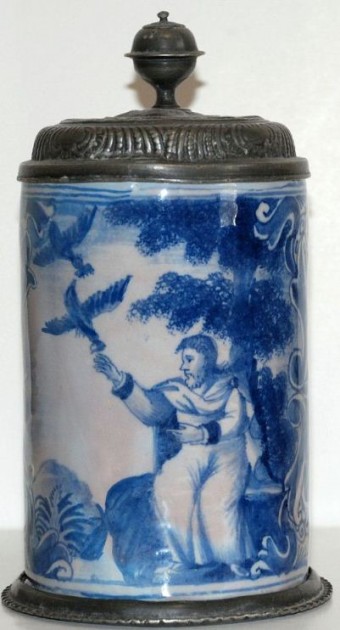
(Photo compliments of William Hamer.)
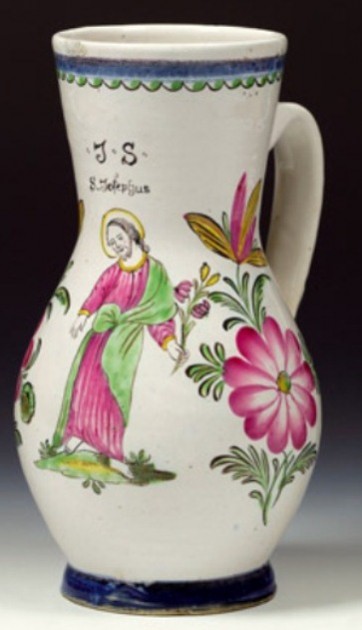
Austrian Fayence, not certain of name –(Photo compliments of William Hamer.)
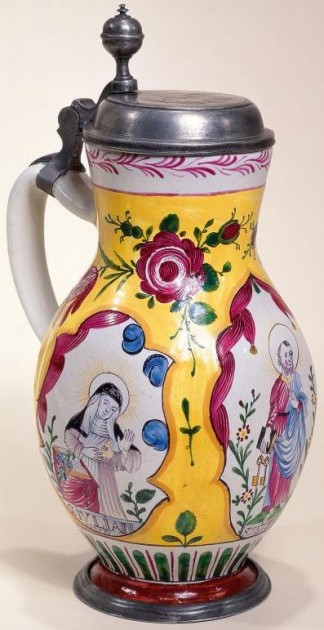
Austrian Fayence, not certain of name –(Photo compliments of William Hamer.)
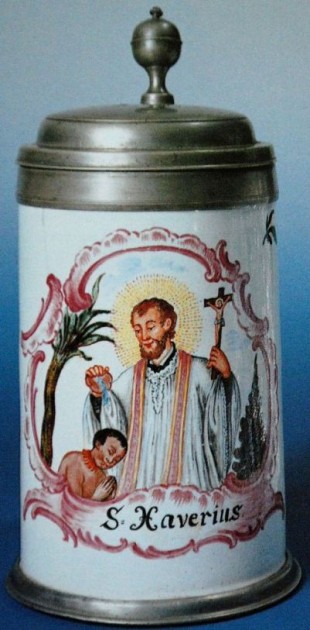
No listing found for St. Haver. Must have been a very local Saint. (Photo compliments of William Hamer.)
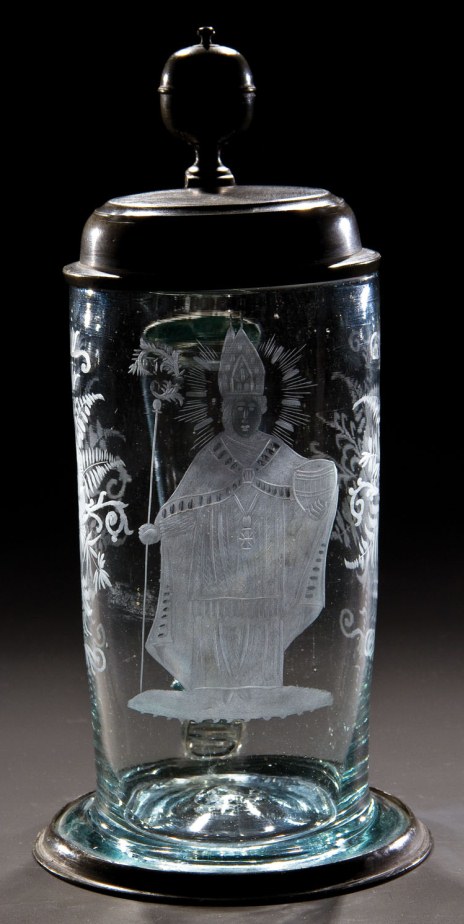
An unknown Bishop / Saint on an engraved clear glass stein from about 1760-90.
BELOW – THE VIRGIN MARY— AND / OR THE CRUCIFIED CHRIST
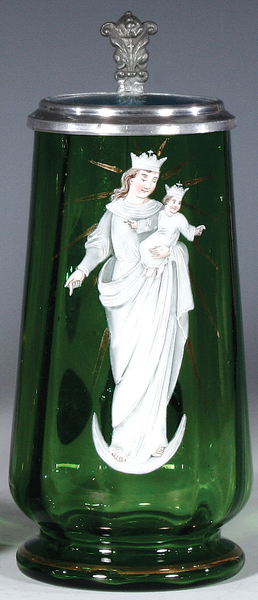
The Madonna and the baby, on an German enameled, mouth blown, .5 liter green glass stein Circa 1880. [TSACO]
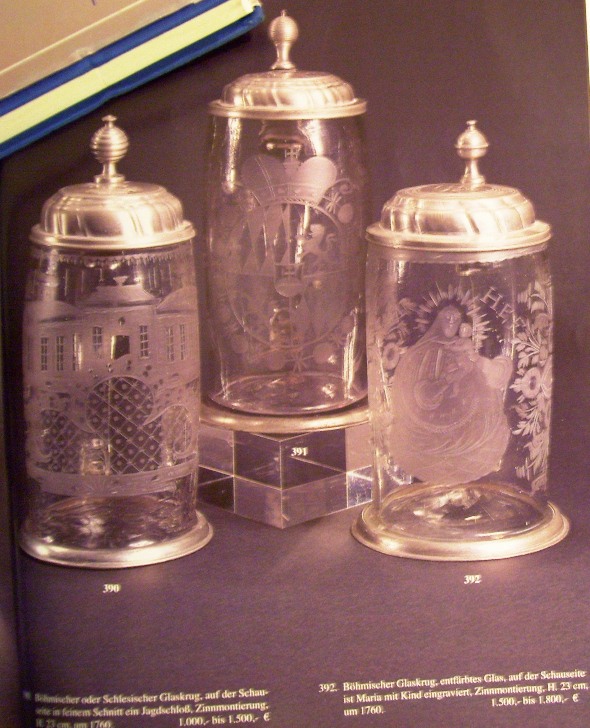
“The Virgin Mary” [1] –What is there to say. If you haven’t heard of Mary, the mother of Jesus, you must have been hiding under a rock. [On right] Mary, Mother of Jesus, holding the baby Jesus. (Photo from an old J. Vogt’s [Munich] catalog.) The floral pattern on the side indicates this was also done by the artist I call “The Master of the Engraved Saint Steins, (TMOTESS)”
“The Virgin Mary” [2] – Far left: Another old catalog photo with Mary and the baby perched on her left arm. I do not think, based on what I can see in the photo, that this engraving is the work of “TMOTESS.”
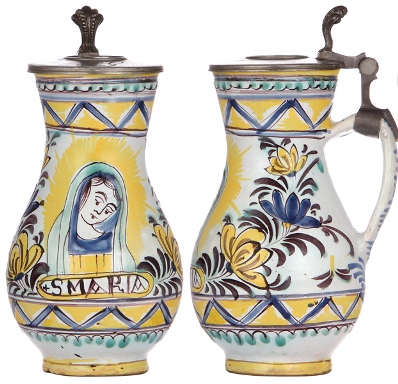
The Virgin Mary [3] – The yellow behind her head is the halo! .5 liter Austrian Fayence Birnkug. Early to mid 1800’s. [TSACO]
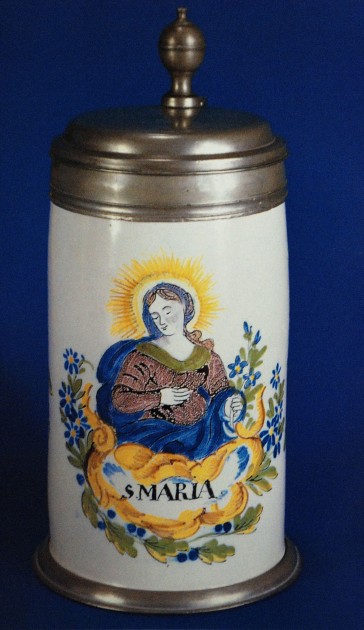
The Virgin Mary [4] – (Photo compliments of William Hamer.)
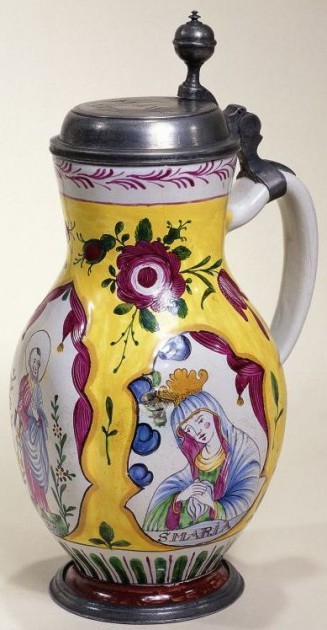
Austrian Fayence The Virgin Mary [5] – (Photo compliments of William Hamer.)
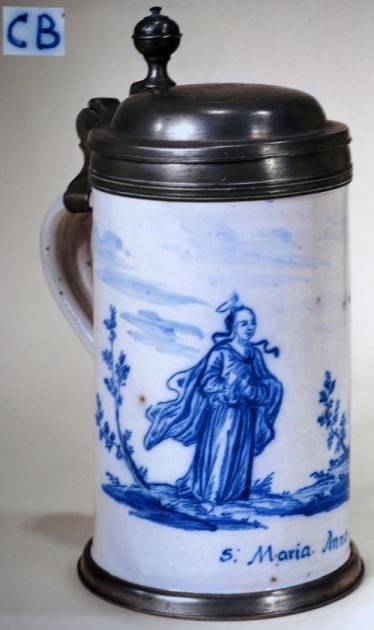
The Virgin Mary [6] – (Photo compliments of William Hamer.)
THE HOLY FAMILY AND / OR JESUS
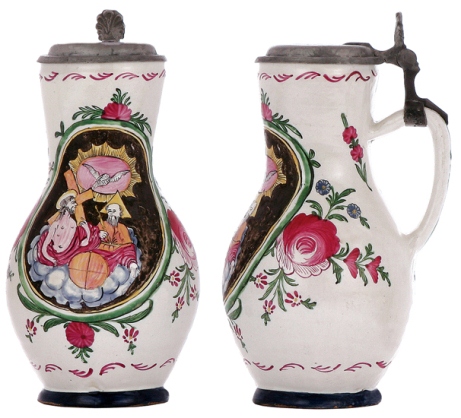
The Trinity: The Father, Son and Holy Spirit. Faience stein, 1.25L, 10.7 ht., Loebersdorf, late 1700’s .
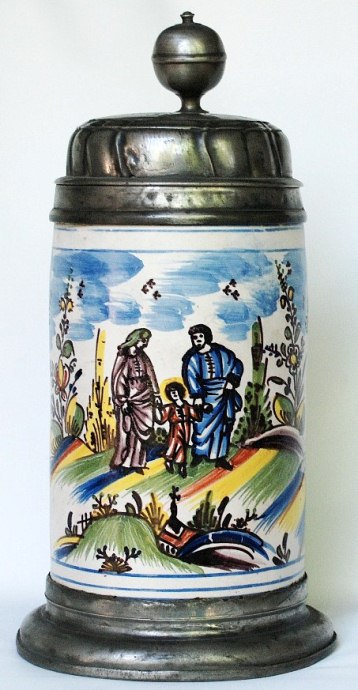
The Holy Family, from Erfurt, 1 liter fayence
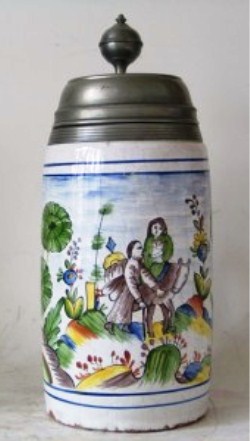

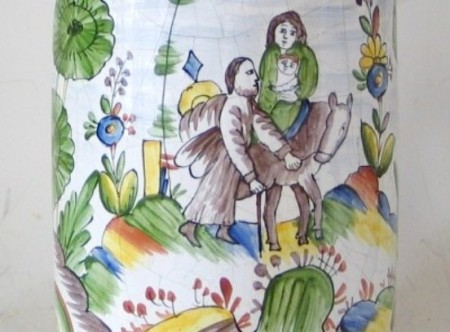
Detail of the Holy Family on their trip to Bethlehem, on a circa 1950-80 fayence piece. Induced crazing, but still nice workmanship.
JESUS
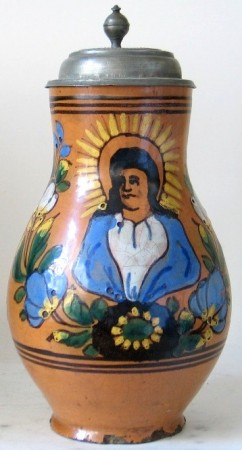
I think this is supposed to be Jesus , but not 100% certain. Austria. Ca. 1850. [S.A.]

(Photo compliments of William Hamer.)
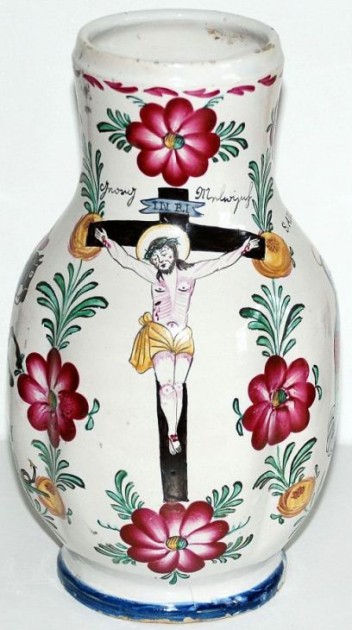
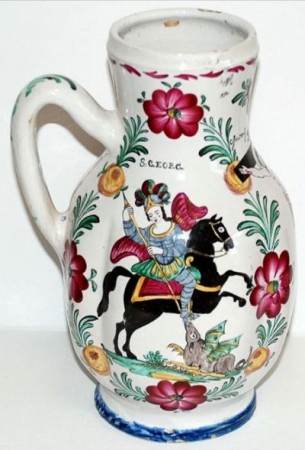
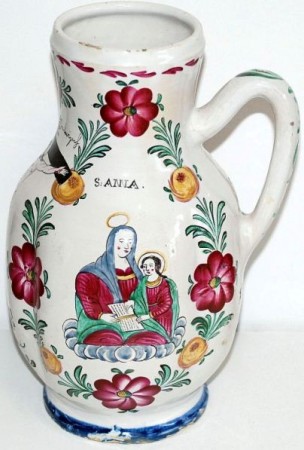
This little .5 liter Austrian, Circa 1813, Leobersdorf birnkrug is loaded with nice religious scenes: Jesus, St. George and St. Anna! Nicely painted too. (Photos compliments of William Hamer.)
MULTIPLE SAINTS – When several saints are pictured they are usually those saints known as the Apostles (The Apostles – Apostolos (Apostle) means one who is sent forth, who is entrusted with a mission) or the four evangelists who wrote the gospels = Matthew, Mark, Luke, and John.
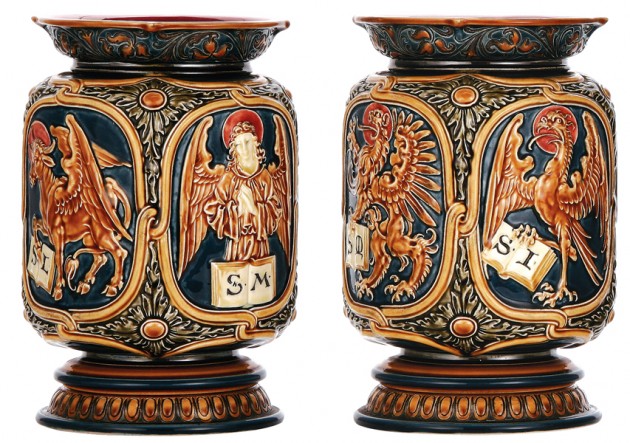
While not a stein this pieces is very interesting A V & B Mettlach vase. 8.6 INCH ht., #1857, decorated relief. This great piece showS the four evangelists: SL = St. Luke (Ox) ; SM = St. Matthew (Angel); SM = St. Mark (Lion); SJ =St. John (Eagle). [tsaco]
.
A large RussianBratina or friendship cup (really it is a small bowl as it has no handles) with a bulbous middle. Made in all metals, but mostly silver with enameled designs. Above: A baked enamel, copper based, Bratina, from the 1600’s with symbolic scenes of Matthew, Mark, Luke and John.

All three shown above are from Creussen in the late 1600’s. These are also called Apostle steins as those are the Saints that are featured. Of course the colored version now sells for lots more than the plain brown relief.
.

An unpainted one liter example of an Apostle’s stein, now in the FWTD collection. The reddish-brown c0lor threw a lot of collectors “off” of this one, which was fine with me!, [SA]
see; “APOSTLE STEINS” IN THIS SITE’S COMPENDIUM FOR FOR MORE PHOTOS

Apostles steins — Creussen, one liter,. Circa 1660 (JM -DH)


Above: two late 1800’s reproduction Apostle steins. [L] Saltzer factory.[R] Unknown. Because the originals are now too expensive for most, eveen the 1880-1900 reproductions are getting good money. The stein to the left (by A. Saltzer) would probably bring $900 to $1100 at auction today. It is extremeely well made. BUT some are not and have lost a lot of their enameling.


.5 liter Apostle’s stein. Newer version, Unknown maker. Circa 1890.

A new “limited edition” of an Apostle’s stein. Made by Gerz.
Witlaf, a king of the Saxons,
Ere yet his last he breathed,
To the merry monks of Croyland
His drinking-horn bequeathed,–
That, whenever they sat at their revels,
And drank from the golden bowl,
They might remember the donor,
And breathe a prayer for his soul.
So sat they once at Christmas,
And bade the goblet pass;
In their beards the red wine glistened
Like dew-drops in the grass.
They drank to the soul of Witlaf,
They drank to Christ the Lord,
And to each of the Twelve Apostles,
Who had preached his holy word.
They drank to the Saints and Martyrs
Of the dismal days of yore,
And as soon as the horn was empty
They remembered one Saint more.
And the reader droned from the pulpit
Like the murmur of many bees,
The legend of good Saint Guthlac,
And Saint Basil’s homilies;
Till the great bells of the convent,
From their prison in the tower,
Guthlac and Bartholomaeus,
Proclaimed the midnight hour.
And the Yule-log cracked in the chimney,
And the Abbot bowed his head,
And the flamelets flapped and flickered,
But the Abbot was stark and dead.
Yet still in his pallid fingers
He clutched the golden bowl,
In which, like a pearl dissolving,
Had sunk and dissolved his soul.
But not for this their revels
The jovial monks forbore,
For they cried, “Fill high the goblet!
We must drink to one Saint more!”
Written by: Henry Wadsworth Longfellow.
[END – SOK – 86 – needs 4d and r5 ]
 “Asking a stupid question is most often better than repairing a stupid mistake.”
“Asking a stupid question is most often better than repairing a stupid mistake.”
SOME OF THE MANY FAYENCE BEER STEINS DEDICATED TO ST. GEORGE
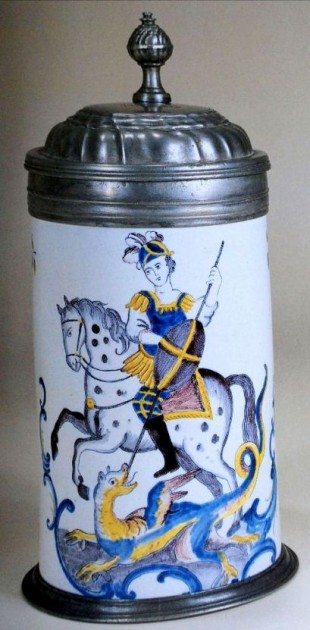
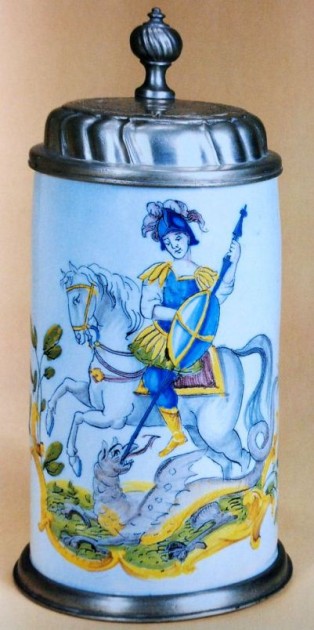
.
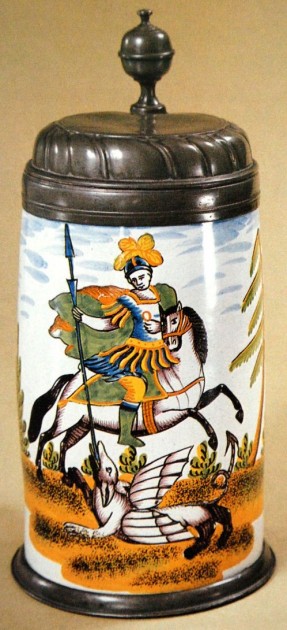
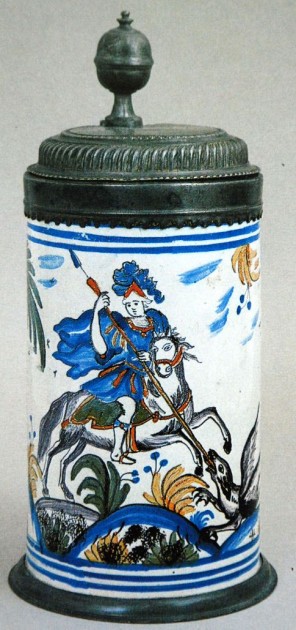
.
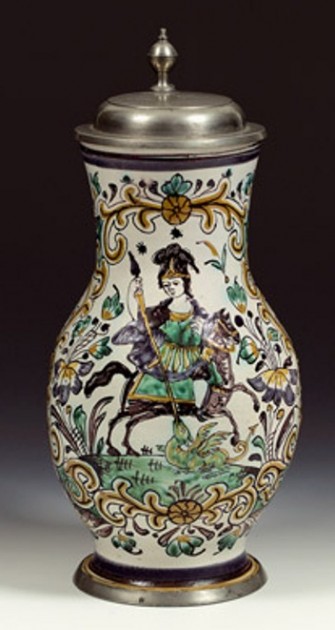
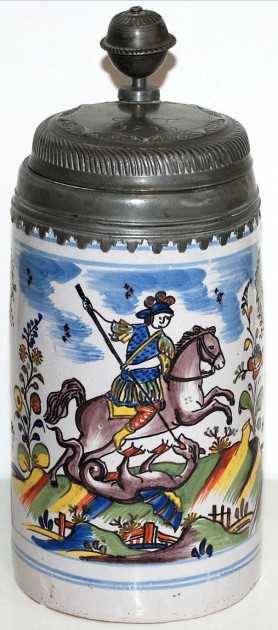
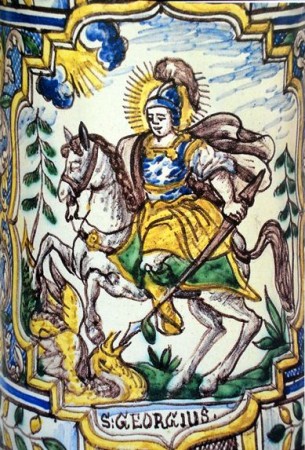 [on]
[on] 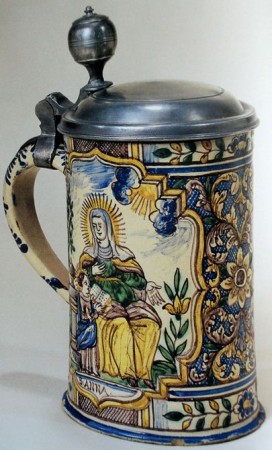

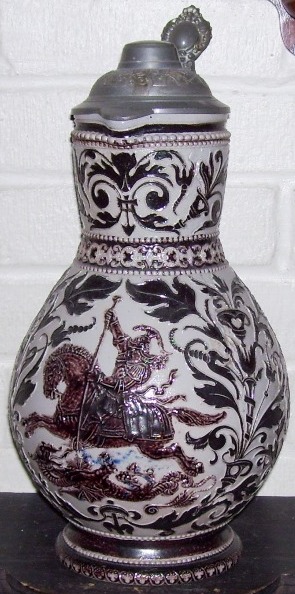
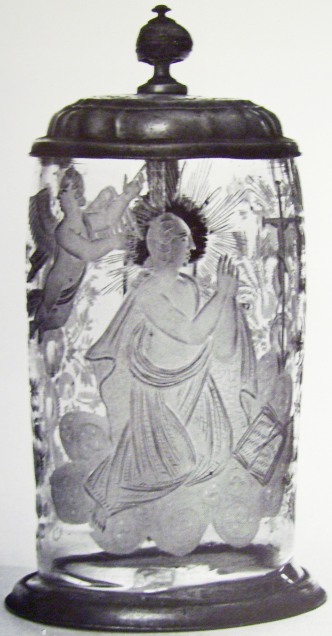
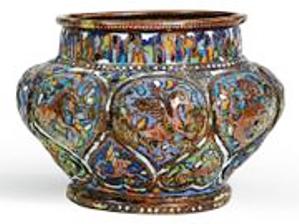
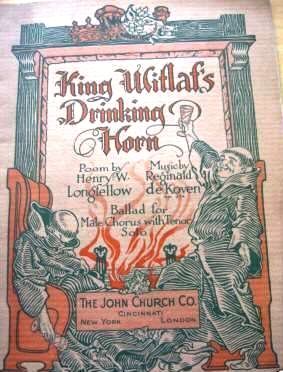
Leave a Reply